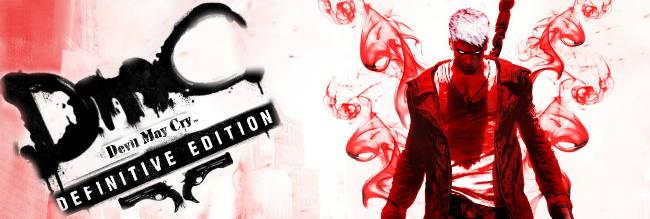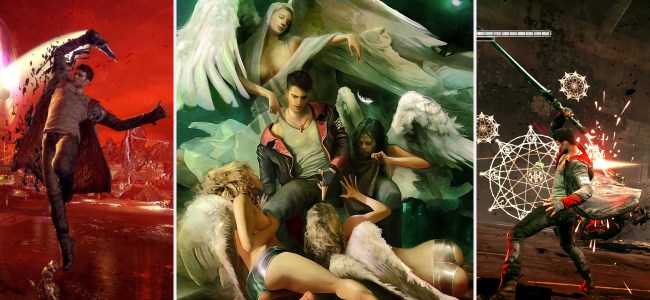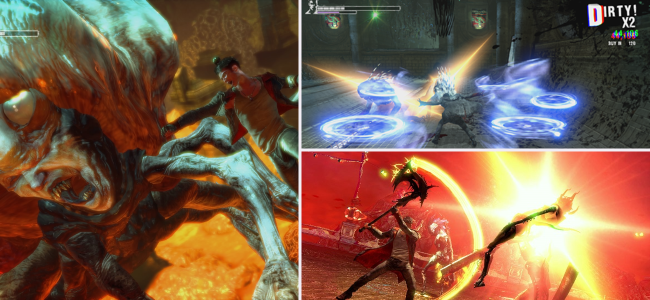
I was surprised by how awesome DmC: Devil May Cry was back in 2013. Having gone in with low expectations, I was absolutely blown away. Now, two years and one generation on, DmC Devil May Cry: Definitive Edition gives me the chance to experience it all again – plus some extras. Included is all original content, the Vergil’s Downfall DLC, new Bloody Palace arena options, new difficulties, Turbo Mode, Hardcore Mode, and a handful of player skins. On top of the bonus content, the Definitive Edition is uprezzed, running at 60 fps in 1080p resolution, and hosts several balance and gameplay tweaks. This is certainly the definitive DmC package.
DmC is a clever and unique story of angels and demons. In a modern world, demons choose not to control man through trepidation and typical evil tyranny, but through energy drinks and TV networks. As Dante, a demon hunter, you’ll travel between Limbo; the realm of the demons and the existential plane of man. When Dante joins up with an organisation known as “The Order”, he finds himself taking down these means of control and working his way to defeating the big baddy; Mundus. This is one of the most interesting and creatively developed video game worlds I’ve come across. The fusion of archetypal fantasy conventions with modern culture provides a relatively grounded and relatable conflict while still going crazy with all the anime-style enemies and combat.

What really sells me on DmC’s story though, is the awesome but divisive writing. I love the characters and how they interact with one another. I’m not a fan of constant obscenity in games, and this is one of the things for which DmC is often criticised. In this case though, it isn’t just about making it arbitrarily more ‘adult’ – it’s a joke. A lot of the dialogue and acting is tongue-in-cheek and not to be taken too seriously, and that keeps the story fun. That’s not to say there’s no meaningful character development here though. Dante’s irreverence put side by side with some surprisingly emotional scenes build an interesting persona, while his cunning and confident expressions and mannerisms help keep it feeling genuine. Dante is the typical ‘cool hero’ you’d say in every game in the 90s, but fleshed out, well written and surrounded by a setting in which he makes sense. A fitting reboot, I think.
Devil May Cry is all about the action though, and DmC delivers in this field exceptionally. Combat is kinetic, frantic and fast-paced, but deliberate, elegant and focused. Dante has some real cool moves, but none are hard to pull off. A brilliant control scheme ensures that even as you amount a sizable collection of weapons, attacks and combos, nothing is difficult to execute. Successful combat results from skilled playing and well thought out attacking and evading, not from being able to move a stick ¾ of a rotation and press eight buttons quickly. Combos start out simple – two buttons for melee attacks, one for firearms. Before long though, you’ll be holding R2 to use demon weapons, L2 for Angel weapons, using the D-pad to cycle through your arsenal, and grappling towards enemies to link up your moves.
The possibilities for combos are endless, keeping combat interesting for the duration of the game and beyond. You’ll want to try to mix things up too – the game will reward you for it. The style system ranks your encounters according to how stylishly you’re playing, that is, how many different attacks and combos you’re using successfully in close succession to one another. You can kill most of the games enemies by mashing the triangle button, but you’ll be missing out on rewards, and on fun. The Definitive Edition even features Must Style Mode, in which enemies only take damage while being fought stylishly. SSSENSATIONAL!!!

My favourite thing about DmC is the excellent level design. At this point, we’ve all played our fair share of gothic towns, snow levels, dungeon levels, all the kind of stuff I’d expect from previous Devil May Cry games. How about playing inside of a TV news show, jumping on graphics as they fly past? What about a nightclub/fight club/talent show, built of glowing, moving tiles and surrounded by dancing neon waveforms? You probably haven’t played that before. You probably won’t ever play that anywhere but in DmC, and that’s special. It is far from often that something this original makes its way into a video game, and DmC is full of these kinds of ideas. Everything is very conventional for an action game at it’s core, but layered with depth and originality. The same goes for the great boss battles.
I love the little things with which this game is laced. The fact that all breakable objects wither within red vines, providing a visual cue that they’re destructible, or the way every trophy is tracked on screen as you make progress towards it. It’s paced so well too, on all levels. Every level balances combat, exploration, platforming and exposition perfectly. Upgrades and new weapons become available constantly, giving you just enough time to master one before giving you the next. Characters and situations develop quickly, and you’ll never spend too much time in one place, but no scenario is rushed through. The game seems fairly short, but after 10 or so hours of gameplay, nothing feels remotely overused or tired. Once you’ve finished the game, there’s still a lot to do. Collectibles and hidden secret missions can be found by replaying levels, or you can try your hand at Bloody Palace – a wave based combat arena. There are also about two billion difficulty options to work your way through, each with interesting twists on the game’s health, combat and style systems.
I hadn’t played Vergil’s Downfall until this release. I was, unfortunately, disappointed with it. Vergil plays differently to Dante, feeling more sluggish and less proficient in the air, and I appreciated being given something different. As a package though, it all feels a bit unfinished. Exposition is provided in the form of animated sketches, which just seem out of place. They almost seem like placeholders that were never changed or updated. The missions felt like they dragged on to me. Compared to DmC proper, it got a bit boring, especially considering one area is played through twice in a story that’s only a couple of hours long.

DmC was a good, but not amazing, looking game on last-gen consoles. The visual updates in this release are certainly noticeable, for better and for worse. Everything that looked good before looks even better now, but things that only looked okay now look bad by comparison. Certain textures and models just look old when you put them next to the updated and improved stuff. The game runs very smoothly at 60fps, which actually caught me off guard with how nice things look and play. More important than the visual fidelity though, is the art design, and this remains superb. Throughout dark and modern settings, Ninja Theory doesn’t shy away from using colour. Every setting in the game has a distinct visual style, separating it from the rest of the game, and from common game motifs. To top it all off, an awesome soundtrack is provided by Combichrist and Noisia. Heavy hardcore and electronic music fit so perfectly into DmC’s world, providing an extra layer to the atmosphere already so well developed. I associate this game with it’s soundtrack more-so than most, and I really couldn’t imagine it being the same with anything else.
I did have some issues with the Definitive Edition. The game crashed on me a couple of times, and my save was corrupted and lost. It’s probably not a super common thing, but I have come across a few people online suffering from the same issue.
 Interesting characters
Interesting characters Intense but intricate combat
Intense but intricate combat Awesome world design
Awesome world design Great pacing and structure
Great pacing and structure
 Some visuals look outdated
Some visuals look outdated
 Vergil’s Downfall feels rushed
Vergil’s Downfall feels rushed
DmC: Devil May Cry was one of the best action games on the last generation of consoles, and now it’s one of the best on this one. Everything in DmC is cool; the characters, the world, the visual design, and outside of some lacking visuals and bugs, it’s hard to find fault with the core game. Vergil’s Downfall is a disappointing piece of DLC, but it’s hard to argue with getting it at no extra cost in this release. If you didn’t play DmC last-gen, I’d recommend doing it now. If you were disgusted by a Devil May Cry game not featuring Dante’s original design, throw on the classic Dante skin and get over it. DmC is an exceptional video game, and this Definitive Edition provides plenty of upgrades and new content.
EDITOR NOTE: this game was supplied to us by the publisher, and reviewed on PS4 across 18 hours of gameplay.











